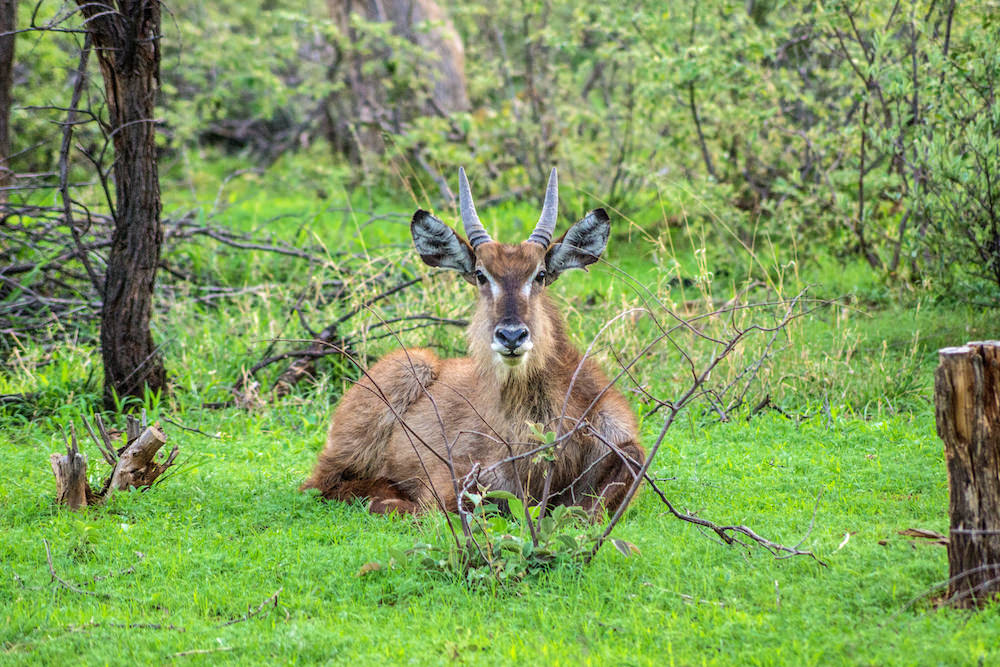They arrive to spend the weekend in the bush, but first they make a fire, pour a couple of drinks and make enough noise to scare off all the residents. Late on Saturday morning after sleeping in, they jump into their safari vehicles with laughter and more drinks on tap. This moving disco on wheels then proceeds to look for animals as this is the reason they came to the Bush after all.
Herd of Impala | © Photography by Marthinus Duckitt
Great are their surprise when they don’t spot anything as they race through the reserve at high speed. On Monday, they tell their friends the place is a bust, and there are no animals at the Mabalingwe Nature reserve. They then get on to social media to loudly express their indignation.
Then we have the instant gratification group. Arriving at the gates demanding to see the Big 5. “Where is the Rhino?” they shout and in a cloud of dust they all descend on the last known location the Rhino, Elephant and Buffalo were spotted. Oblivious to the Nyala, Kudu, Impala, Giraffe and many more animals along their way. Yes, you guessed it! On Monday, they tell anybody that will listen that there are no Big 5 at the Mabalingwe Nature Reserve.
Zebra at Mabalingwe | © Photography by Marthinus Duckitt
The reserve can roughly be divided into eight areas. Cyferfontein – here you will find trees intersect with open areas. This area is popular with all animals in spring. The Itaga area consists of two parts. The
Time to set the record straight. If you don’t want to put in the effort and only escape to the Bush to behave like hooligans, why not camp out in your backyard? You will be doing us all a favour.
Mabalingwe Nature Reserve is 12 500 hectare of bushveld. Let’s put it into perspective. Many sports fields have an area that is comparable to a hectare, so imagine 12 500 soccer/rugby fields next to one another, or 417 Golf courses. Yes, that’s big! If you don’t know where to go, don’t know the habits of the different animal species and don’t know how to navigate your way through the reserve, then the chances of spotting animals will be greatly reduced.
For first-time visitors to the Mabalingwe Nature Reserve, a guided game drive (by the Mabalingwe rangers) is highly recommended. The Rangers will help you get your bearings in this large Reserve and also show you where the animals.
Wildebeest at Mabalingwe | © Photography by Marthinus Duckitt
Itaga Lodge area is frequented by Wildebeest, Zebra, Giraffe, Impala, Nyala and Gemsbok. The Itaga area closer to the Mabalingwe entrance gets visited by Bushbuck, Kudu, Zebra, Blesbuck, Waterbuck and Giraffe.
Wessels Dam | © Photography by Marthinus Duckitt
The Dams area span from the Mabalingwe timeshare area all the way up to the Idwala section of the reserve. This area features spectacular scenery and is home to a pod of 16 hippos and some crocodile. Move up passed the Gorcum Dam and you are in the hills of Idawala where there have had a few recent leopard spottings. To the right of Idwala, you have Elandsfontein where the elephant come to hide away from humans when they want to be alone. To the left of Idwala, you have vast grassland and spectacular scenery where Giraffe, Zebra, Blesbuck and Wildebeest graze. This area is the most difficult to navigate as the roads are only accessible by 4X4.
To the right of the Mabalingwe airstrip, you will find the dense, bushy part of the reserve. With lots of Timbotie trees, the Kalahari Oasis bar (a must visit) and the most amasing camp in all of Mabalingwe, the Pitsi Bush Camp. If you have a need for ultimate privacy and a great bush experience, this camp is a must. Here you will also find the Kameelperd water hole, a favourite of the Mabalingwe elephant herd.
Mabalingwe Elephants | © Photography by Marthinus Duckitt
The elephant herd at Mabalingwe live in a tight social unit led by an older matriarch. At the moment, there are youngsters of different age groups in the herd, from recently born to teenagers. Elephants can give birth every three to four years. The gestation period is almost two years. The young calves have made the herd very protective and secretive. The herd is estimated to consist of about 24 elephants.
Mabalingwe Lions | © Photography by Marthinus Duckitt
Like many other private game reserves, the Lions at Mabalingwe are contained in a separate, high-security fenced area of the reserve. To visit the lion enclosure – (Wednesdays and Sundays at 9am) one has to book at the Mabalingwe reception. There is a misconception that the Lions are restricted to a very tiny area, and nothing can be further from the truth. The Lions stay in 80 ha of bushveld that is just about three golf courses.
Mabalingwe Giraffe | © Photography by Marthinus Duckitt
On an average weekend visit (Friday to Sunday) you are just about guaranteed to see Impala, Giraffe, Nyala, Kudu, Warthog, Waterbuck and the Hippo. Chances are also good that you will spot Wildebeest, Zebra, Buffalo, Blesbuck, Klipspringer and Duiker. Count yourself lucky if you encounter the Elephant, Rhino, Mountain Buck and crocodile. If you spot leopard or Sable, you have joined the select few. These animals are extremely shy, and there are many places for them to hide.
Mabalingwe Nature Reserve is a place of many surprises. The reserve has to manage the needs of a diverse group of stakeholders. On the one side, you have private homeowners that expect complete freedom of movement. On the other side, you have the weekend guests that are just too lazy to familiarise themselves with this environment.
Mabalingwe Kudu bull | © Photography by Marthinus Duckitt
Balance this with the security needs of visitors and the need to protect the animals from poachers without causing undue inconvenience to guests and you have the potential of all kinds of conflict arising. Recently poachers killed two of the reserves Rhino which has necessitated more security throughout the reserve. For that reason, staff will not casually tell you how many Rhino there are and where you can find them.
For the return visitor, Mabalingwe Nature Reserve can be a rich and rewarding experience, all it takes is a bit of homework and a genuine appreciation of the Bushveld. The appeal of Mabalingwe is not it’s game park or the variety of animals but the free roaming of the game around the areas where visitors stay so that one can observe the behaviour of these wild animals at close range and in extreme comfort.
Mabalingwe Buffalo pays visit to filling station | © Photography by Marthinus Duckitt

















